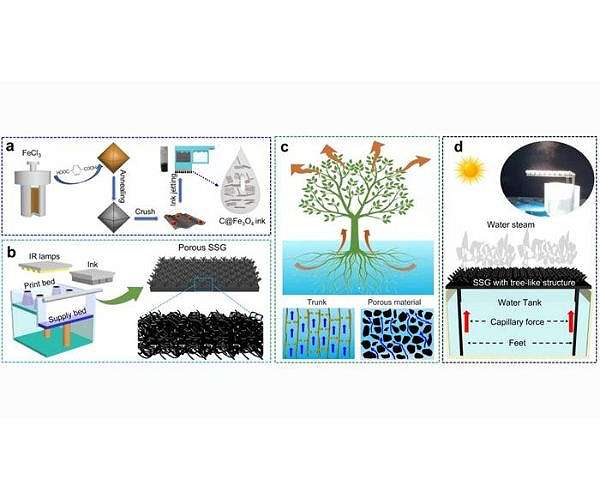3D printed forest with microstructure improves solar steam desalination
To tackle the global problem of freshwater scarcity, researchers in Singapore have developed advanced solar steam generators (SSGs) for seawater desalination. Powered by renewable energy, this method mimics the natural water cycle by using solar energy to evaporate and purify water, offering a potentially cost-effective solution compared to traditional, energy-intensive desalination techniques. However, current SSG technologies face limitations due to the complexity of fabricating designs that maximize surface area for optimal water evaporation.
Inspired by nature, the team used 3D printing to create innovative SSGs. Their findings, published in Applied Physics Reviews, highlight a new technique for fabricating efficient SSGs and introduce a breakthrough method for printing functional nanocomposites using multi-jet fusion (MJF).
“We have created SSGs with exceptional photothermal performance and self-cleaning properties,” said Kun Zhou, professor of mechanical engineering at Nanyang Technological University. “The use of a tree-like porous structure significantly improves the water evaporation rate and ensures continuous operation by preventing salt build-up – performance remains relatively stable even after long-term testing.”
The technology works by converting light into thermal energy, with SSGs absorbing solar energy and converting it into heat to evaporate water. The porous structure of the SSGs aids in self-cleaning by removing accumulated salt, ensuring sustainable desalination performance.
“By using an effective photothermal melting agent, the MJF printing technology can quickly create parts with intricate designs,” Zhou added. “To improve the photothermal conversion efficiency of fusing agents and printed parts, we developed a new type of fusing agent derived from metal-organic frameworks.”
The SSGs feature miniature tree-shaped microstructures that mimic plant transpiration to form an efficient, heat-distributing forest.
“Our bio-inspired design increases the surface area of the SSG,” explains Zhou. “Using a tree-like design increases the surface area of the SSG, which improves water transport and increases evaporation efficiency.”
In both simulated environments and field tests, the SSGs exhibited high water evaporation. The demineralized water consistently met drinking water standards, even after extensive testing.
“This demonstrates the practicality and efficiency of our approach,” said Zhou. “And it can be mass-produced quickly and easily via commercial MJF printers.”
The team’s work shows significant potential for addressing freshwater scarcity.
“Our SSGs can be used in regions with limited access to freshwater to provide a sustainable and efficient desalination solution,” said Zhou. “In addition to desalination, it can be adapted for other applications that require efficient solar energy conversion and water purification.”
Research report:3D printing of bio-inspired porous polymer solar steam generators for efficient and sustainable desalination


